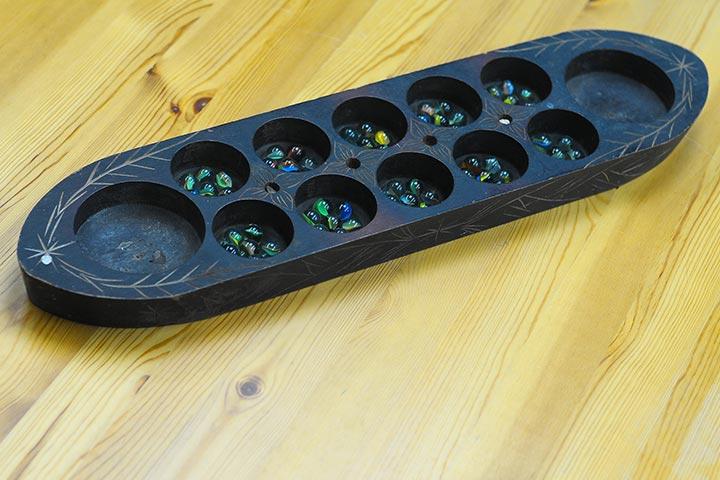
Now, there are some house Mancala rules that you can add to the game of Kalah for more variety as well: Now keep playing, because this game is addictive. The player with the most pieces in their Store wins the game. The opposite side player then collects all the remaining pieces in their pits and places them in their store. Nice! Ending the GameĪs mentioned, the game ends when all the pits are empty on one side of the board. Place all these captured pieces in your store and gather up those points.

If you drop your last piece during a turn into an empty pit on your side of the board, and the opposite pit has one or more pieces left in it, you get to collect your last piece and the pieces from the opposing pit. There is no limit to how many consecutive turns you can take during a game.Ģ. If during a turn you drop your last piece into your own Store, you get another turn. The game moves in this fluid, counter-clockwise fashion until one player has emptied all the pits on their side. Just skip over and proceed to the next pit on your side. However, you do not deposit a piece in their Store. If you cross over to your opponent’s side, you deposit a single piece in each of their pits. If you pass your Store, you deposit a single piece in it. You take turns by picking up all the pieces in one of your pits and moving counter-clockwise around the board, depositing a single piece in each subsequent pit as you move. Let’s talk more about how the game works. The game ends, and pieces in each Store are counted, when all the pits on one player’s side are empty. The object of Mancala is to have the most pieces in your Store at the end of the game. For example, more advanced players like to use 6 pieces in each pit. You can also play with more pieces in each pit to start. To set up a game of Mancala, each player places 4 pieces into each of the 6 pits on their side of the board. When playing the game, facing the board, your Store will be on the right side of the board. These are called Stores, also known as Mancalas. Notice there is a longer pit at each end of the board. See the following image for a typical Mancala board layout. These are also called pods, pockets, or houses. The board that has two rows, each with six hollowed-out pits. The game pieces may be marbles, plastic or glass “seeds”, beans or stones. You need a Mancala board and game pieces.
#MANCALA RULEA HOW TO#
You might also like: How to play Go, one of the world’s oldest board games. It looks simple, and doesn’t take long to learn, but people have been playing and mastering this game for thousands of years, so you know there’s a lot of skill and strategy involved. Kalah is a two-player strategy game that is fun for kids and adults. So, if you want to learn how to play Mancala, this is a good place to start. Kalah is the version of Mancala you will likely play if you purchased a Mancala board in a store or online. This guide will provide an overview of the rules for each of these Mancala versions, starting with the most popular commercial version: Kalah. Other well-known versions include Oware, Congkak, and Togus Kumalak. The most popular version of the game is known as two-rank Mancala, or Kalah. Whether you have never played or you’re an expert, the number of variations and different rules are fascinating. Takes the stones remaining in their pits and puts those stones in their store.Ĭount up the stones, whoever has the most wins the game.This post provides an overview of how to play Mancala, a family of strategy board games played around the world for centuries.

The game is over when one player’s pits are completely empty. Put those captured stones, as well as the last stone that you just played on your side, into the store. When the last stone in your hand lands in one of your own pits, if that pit had been empty you get to keep all of the seeds in your opponents pit on the opposite side.When the last stone in your hand lands in your store, take another turn.Players alternate back and forth, with opponents picking up the stones in one of their pits and distributing them one at a time into the pits on the right, beginning in the pit immediately to the right You may end up putting stones in your opponent’s pits along the way. If you come to your store, then add a stone to your store and continue. On a turn, a player picks up all the stones in one pit and“sows” them to the right, placing one stone in each of the pits along the way. Only put stones in your own store, not your opponent’s store. Once you touch the stones in a pit, you must move those stones. That is where you keep the stones you win. Play always moves around the board in a counter-clockwise circle (to the right). The player with the most stones in their store at the end of the game wins. To collect as many stones in your store as possible. (For a shorter game, you can play with three stones in each pit.)

Place four stones in each of the six pits on your side of the game board.


 0 kommentar(er)
0 kommentar(er)
